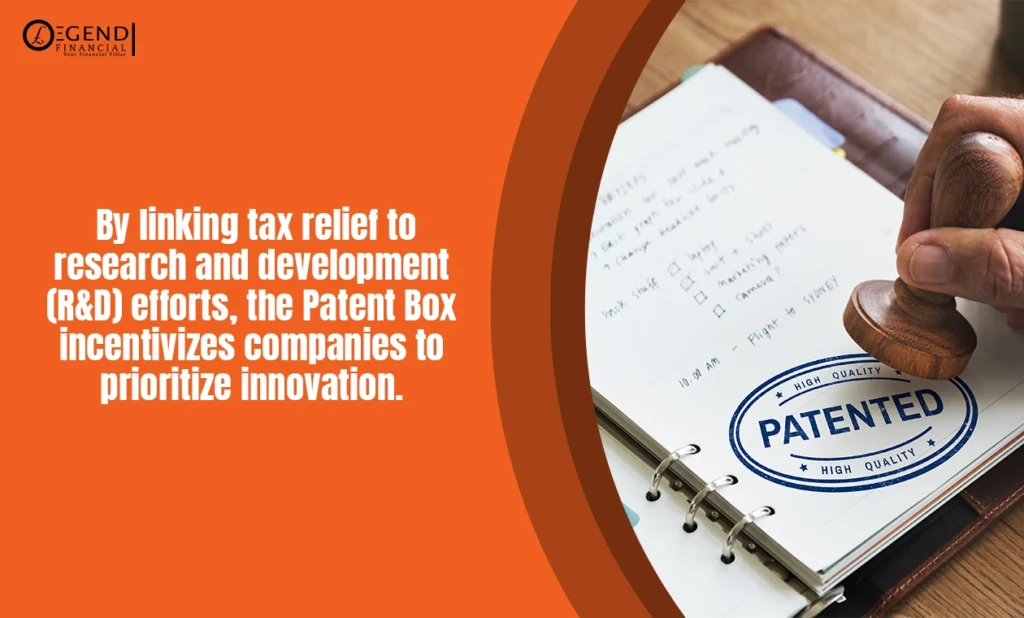Contents
If you are a company that makes and owns its inventions and holds a patent granting exclusive rights to your intellectual property, you will benefit from tax relief under the patent box tax scheme. This article will provide you with everything you need to know about this tax advantage. Keep reading!
What is a Patent Box?
HMRC Patent Box is a UK tax scheme that allows companies to pay a reduced corporation tax on profits earned from patented intellectual property (IP). Under the patent box tax relief, companies can claim a 10% reduced corporation tax rate on profits generated from patented inventions. Its purpose is to encourage innovation and retain R&D activities in the UK. It supports global efforts like the OECD BEPS Project by supporting businesses to develop and manage patents within the UK.

Who Is Eligible for Patent Box Tax Relief?
Industries that commonly benefit from the Patent Box are the ones that invent unique products and technologies protected by patents. Major industries include technology, pharmaceuticals, and manufacturing.
But any other business can also qualify for Patent Box, if it meets the following criteria:
- The company must have ownership or exclusive rights to use the patent.
- Profits must be directly linked to the use, sale, or licensing of patented products or processes.
- Company is liable to corporation tax
- The company needs to have invested time, money, and expertise in developing patented technology.
What Profits Qualify for the 10% Tax Rate?
- Selling Patented Products
- The patented product itself.
- Products incorporating the patented invention.
- Custom spare parts designed specifically for the patented product.
- Licensing Patent Rights
- Profits from selling the ownership of patented rights
- Income from infringement compensation
- Using Patents in Manufacturing or Services
This is done to ensure businesses in diverse sectors, like manufacturing and services, can benefit from the Patent Box when their patented technology generates value.
Patent Box Changes: The Nexus Requirement
The Patent Box rules have evolved over the years, with important updates in 2016 and 2021 to make them fairer and more aligned with global tax standards.
In 2016, the focus was on making sure companies were genuinely involved in developing the intellectual property (IP) they were claiming tax benefits for. It was about ensuring that businesses were not just benefiting from patents they had not actively worked on.
Then in 2021, the “nexus” requirement was introduced. This means companies now need to show a clear link between their R&D activities and the profits they make from their patents. If a company is truly investing in innovation, they can claim the reduced tax rate, but if they are not, they will not get the benefit.
Key Features of the Nexus Requirement:
- R&D Connection: Companies must demonstrate a clear connection, or “nexus,” between their R&D work and the profits benefiting from the Patent Box.
- R&D Fraction: This nexus is measured using an R&D fraction, calculated cumulatively from 1 July 2016.
- Cost Tracking: Businesses need to track and trace R&D expenditure as part of their Patent Box claim process. This can be aligned with existing R&D claims to simplify reporting.
Benefits of the Patent Box
The Patent Box offers substantial tax savings, especially after the recent changes to the corporation tax rate. Previously, with the main corporation tax rate at 19%, the Patent Box provided a 9% tax saving on qualifying profits. However, since April 2023, the main corporation tax rate has increased to 25%, while the Patent Box rate remains the same. Now, whether your company falls under the small profits rate (19%) or the main rate (25%), the Patent Box tax relief will be at 10%, making it more advantageous than ever for businesses with eligible intellectual property (IP) income.
By aligning their R&D efforts with the new rules, companies can maximize their tax savings and make the most of the streamlined process. This means businesses have a clear path to both lowering taxes and reinvesting in their own development.
Patent Box Calculation Steps: Simplified Guide
The Patent Box scheme involves specific steps to calculate qualifying profits and apply the reduced 10% tax rate. Here’s how it works:
1. Identify Relevant Profits
Determine which parts of your company’s profits qualify as intellectual property (IP) income. This includes profits from activities like product sales, royalties, and patent licensing.
2. Apply the R&D Fraction
The R&D fraction ensures that tax relief aligns with your company’s innovation efforts.
- If your company conducted all R&D internally or through third-party subcontractors, and there are no acquisition costs, the R&D fraction is 1.
- This simplifies the calculation and removes restrictions on Patent Box deductions.
3. Calculate the Deduction
The Patent Box scheme creates a deduction that reduces qualifying profits. This adjusted profit amount is then taxed at the reduced 10% rate instead of the standard corporation tax rate.
Tip: Use tools like the Patent Box decision tree or streaming method summaries to make your calculations easier.
How to Claim Patent Box Tax Relief
To benefit from the reduced 10% corporation tax rate under the patent box tax relief UK, companies must formally elect into the scheme. Your company must opt into the Patent Box regime within two years after the end of the relevant accounting period for which relief is being claimed. To apply, you can either write to HMRC or include the relief as part of your calculations when completing a corporation tax return.
Early Election Option
Companies can elect into the scheme before their patent is granted. This allows tax relief to apply to qualifying profits earned during the patent pending period (from filing the patent application to its grant).
Claiming Accumulated Relief
Any tax relief accumulated during the patent pending period is included in the tax return for the year in which the patent is officially granted.
FAQs About Patent Box Tax Incentive
To qualify for the patent box tax relief, the patent must be granted by a European Patent (EP), or a Patent Cooperation Treaty (PCT) patent can also qualify if it is designated for the UK.
Service based businesses do not qualify for the Patent Box. This is because the Patent Box is primarily designed for businesses that generate profits from patented products or processes.
By electing early for the Patent Box, you can claim relief on profits generated from the date of the patent application until the grant.
If your company has acquired IP rights, the benefits of the Patent Box scheme will be restricted. Specifically, if your company has spent money acquiring patents or made payments to connected parties for their R&D expenditure, the profits derived from these acquired IP rights will not qualify for the full reduced corporation tax rate.
Maximise Returns on Your Intellectual Property
We understand how valuable your intellectual property (IP) is, and we are here to help you make the most of it through the Patent Box tax scheme. With the complexities involved in tracking income, expenditures, and R&D activities related to your patents, our team is here to help make sure that nothing is overlooked.











